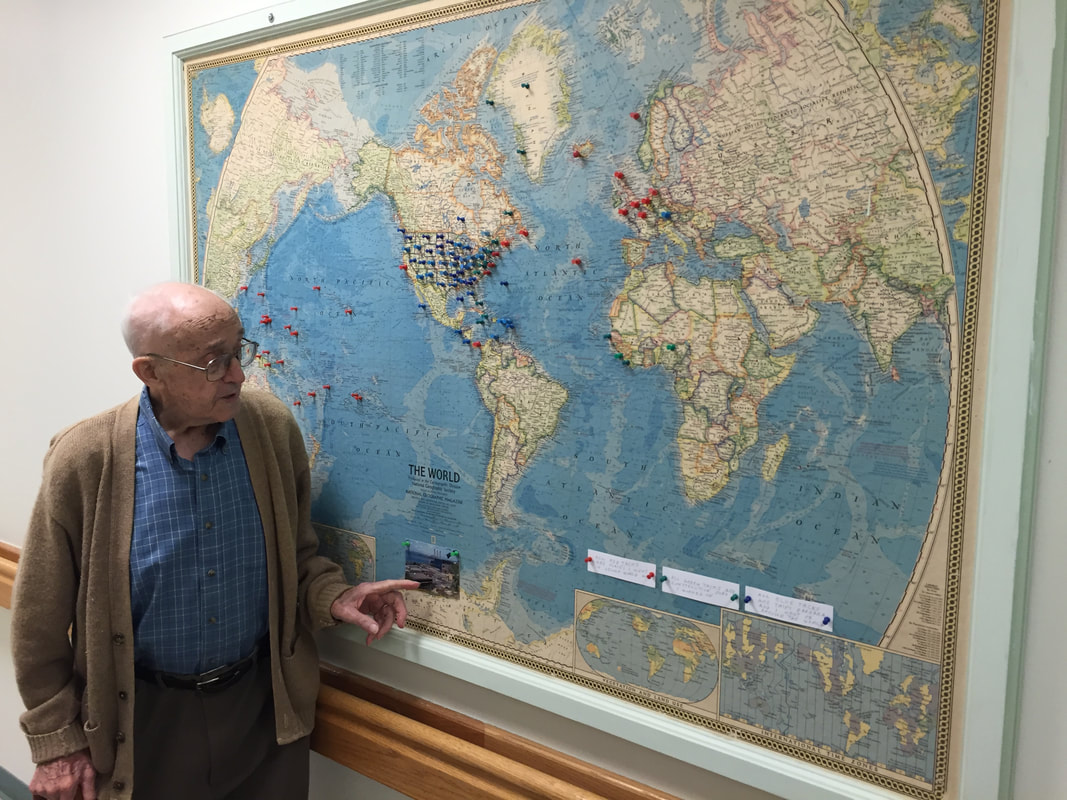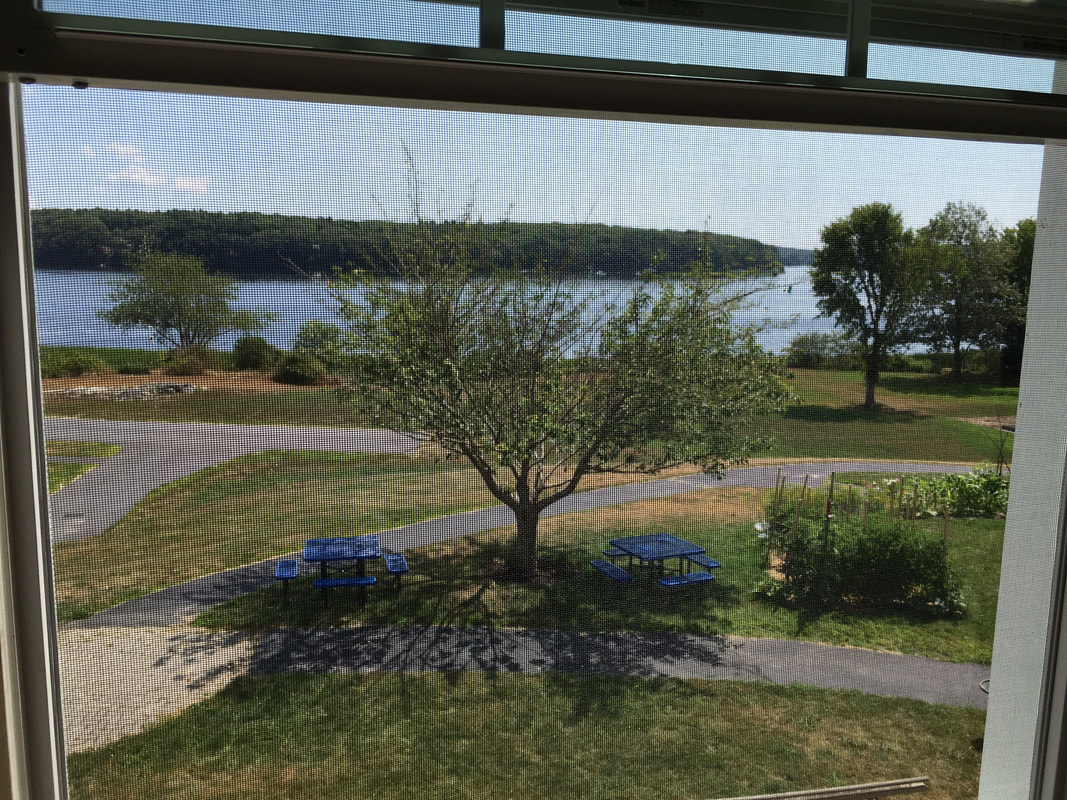 Harold Grundy has visited 66 countries and 49 states. He likes to tell people about the construction he supervised in top-security places like Greenland and northern Maine and Guantanamo Bay. He also ducked bullets and bombs in Europe and Asia while delivering goods during World War Two. Whenever he and Barbara came home to Bath, Maine, they updated the pins on the map – which became the summary of his grand life, soon to reach 95 years. Barbara has been gone for a few years, and recently Harold – my wife’s uncle – began to need more care. He was in the right place – a cottage on the grounds of The Plant Home, alongside the Kennebec River, a 100-year-old retirement home, beautiful and comfortable, idealistically designated for people from the region. Harold held on by himself as long as he could, but when he began to need more care he was moved to the main house. The staff was fussing over him – everybody fusses over him – but he was feeling the huge change, even with a private room overlooking the river he dredged in 1940. How to deal with the tremendous sense of upheaval in his life? Harold is surrounded by good friends from Bath, a real town with thriving shipbuilding and generations of people with long memories and loyalties. Ace, his faithful surrogate son, has been visiting from Arizona. Cookie, a loving surrogate daughter and friend of Barbara’s, has been driving up from Connecticut. Ann, a retired nurse, has been volunteering her expertise. And Martha has been offering rides to doctors. Eric takes him out for breakfast. Dr. Paul, a nephew, has popped in, from his peripatetic life. This is the essence of community. We should all be so lucky. Still, understandably, Harold was having trouble adjusting. Ace and Cookie agreed that he needed more personal touches in his new room, but he was divesting traces of his life, including the map, with all the blue and green and red thumb tacks. The other day, my wife and I dropped in to meet the director of the Plant Home -- Kristi Hyde, a retired lieutenant colonel in the U.S. Army, who served several active nursing tours overseas. This was our first meeting. Ms. Hyde invited us to sit at her desk. She sat squarely and leaned forward and looked my wife in the eye and asked how she could help. I had a flashback to three years in ROTC in college, when we were taught the fundamentals of leadership. (The military knows how to teach responsibility – thank goodness, I say.) Marianne said: “Harold has this map in the cottage…” Ms. Hyde smiled and said (as I recall), “We need to get that over here.” Twenty-four hours later, that large map (with the wooden frame that Harold, a master carpenter, had built) was placed on a wall outside the home’s activities room, where people pass all day. We took him downstairs to show him, and told him Ace and Cookie and Kristi Hyde had wanted that map to be with him. Harold smiled – and pointed – and began telling us stories about a few of his postings – Jamaica, Nigeria, Three Mile Island, and the perilous missions during World War Two. We stayed 15 minutes. There are always new stories. We’re back home now, and Harold is reportedly adjusting to his room squarely facing the river he helped dredge in 1940. He often tells how he ferried explosives into the middle of the river to help the blasters. His life keeps rolling, alongside the Kennebec.
Mendel
8/11/2017 09:51:04 am
Beautiful, George.
George Vecsey
8/11/2017 10:04:23 am
Mendel, absolutely. Getting to know him better the past few years has been a blessing -- then there is Maine. 8/11/2017 11:30:30 am
Wonderful story George. It personifies what is the best in people--doing the little things that matter.
Russell Wilmot
8/11/2017 12:10:49 pm
Thank you for all your caring and your hearts.
George Lewis
8/12/2017 02:15:01 am
A lovely portrait echoes with truth. Cheers!!
George Vecsey
8/12/2017 11:19:25 am
Thanks to all. George, great to hear from you. We go back a long way to NYT....best, G
Walter Schwartz
8/12/2017 11:04:00 am
George,
George Vecsey
8/12/2017 11:23:02 am
Chief, thanks for the lovely note. You saw us after our five-day run upstate and to Maine....almost 24 hours of driving in five days. We're mostly spectators in the care department -- those good friends from Bath are wonderful, and so is the Plant Home -- a gift from a wealthy manufacturer, to his community, a century ago. Good to see you, G 8/13/2017 01:45:32 am
What a sweet post, and what a sweet act of kindness to preserve and display Uncle Harold's map. He seems to have led quite a life. As we say: Until 120!
bruce
8/14/2017 02:40:33 am
george,
Gene Palumbo
8/18/2017 12:17:57 pm
When I go to George’s website, I almost always go straight to the blog, without even glancing at the rest of the page. Just in case any of you have that same (bad) habit, here’s an alert to something you might otherwise miss: up top, in the right-hand column, George has added the link for a really fine piece he did a few days ago. 9/1/2017 09:15:38 am
I am feeling so cheerful to examine your blog post,really dazzling post you have shared and I got so many information from your blog,Thank 9/1/2017 09:51:36 am
Thank you for posting this procedure on how to do your version of pancake. It's quite different from the usual and mainstream pancakes, and I can feel that this is more enticing! 9/11/2017 08:30:23 am
The producer is especially masterminded and the style is respectable. Truly I am thankful for the effort you have done to share the data. That I may need to your site to get chart for necessities by using making. That is the way I can at long last tidy up. I spend for the length of the day considering shopping. I respect the vitalize of finding that epic, regard thing.
Janet Vecsey
9/11/2017 01:37:41 pm
Not sure how I missed this. I loved reading about Marianne's uncle. Hope he thrives in the main house. His map is amazing! Comments are closed.
|
Categories
All
|










